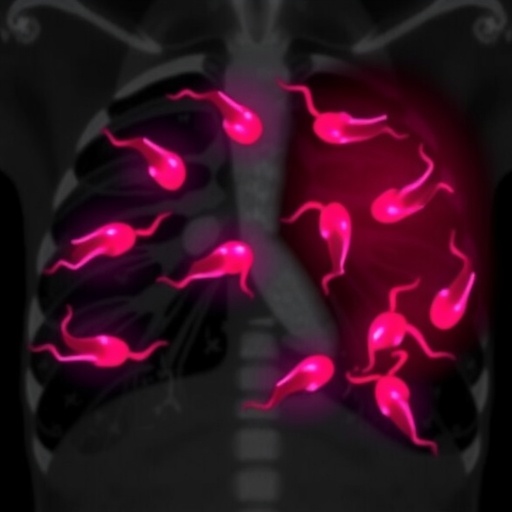In a groundbreaking study published in BMC Cancer, researchers have unveiled the significant role of B-aggressive lymphoma (BAL) proteins as prognostic biomarkers in breast cancer, offering promising new avenues for diagnosis and treatment. The study, led by Zhou et al., investigates the previously underexplored expression dynamics and functional impact of BAL family members—BAL1, BAL2, and BAL3—within the complex biological landscape of breast cancer.
BAL proteins, characterized by evolutionary conserved N-terminal macro domains and a putative C-terminal poly (ADP-ribose) polymerase (PARP) active site, have been implicated in various malignancies. Yet, their specific involvement in breast cancer progression remained elusive until now. This research bridges that gap, elucidating how BAL1 and BAL2, in particular, are intricately linked to breast cancer’s malignant behavior and patient prognosis.
Utilizing an array of powerful bioinformatic platforms, including Ualcan, Gene Set Cancer Analysis (GSCA), STRING, and Gene Expression Profiling Interactive Analysis (GEPIA), the study meticulously dissected the expression profiles of BAL proteins across multiple breast cancer subtypes. What emerged was a compelling pattern: both BAL1 and BAL2 expressions are markedly elevated in breast cancer tissues compared to normal controls, while BAL3 did not show significant differential expression. This discovery suggests a subtype-specific regulatory role of these proteins in oncogenic processes.
Digging deeper, survival analyses conducted through Kaplan-Meier plotter revealed an intriguing paradox—high expression levels of BAL1 and BAL2 correlate with a favorable prognosis across a broad spectrum of breast cancer subtypes, including estrogen receptor (ER)-positive, ER-negative, Basal, luminal B, HER2-negative, and HER2-positive categories. Such findings challenge the conventional understanding of oncogene expression solely as markers of poor outcomes and hint at a more nuanced involvement in tumor biology.
Functionally, the study employed in vitro assays such as CCK-8 for cell proliferation, Transwell migration assays, and TUNEL apoptosis assays to validate the biological roles of BAL1 and BAL2 proteins. Silencing BAL1 and BAL2 genes resulted in a pronounced decrease in breast cancer cell proliferation and migratory abilities, concomitant with increased apoptotic rates. This adds critical mechanistic insight, confirming that BAL proteins modulate key malignant behaviors.
To uncover potential molecular pathways influenced by BAL proteins, the researchers implemented Gene Ontology (GO) and Kyoto Encyclopedia of Genes and Genomes (KEGG) pathway enrichment analyses. These bioinformatics tools highlighted that BAL-associated pathways involve crucial cellular processes like DNA repair, chromatin remodeling, and cellular stress responses, which are vital in cancer progression and therapy resistance.
The presence of macro domains within BAL proteins aligns with their participation in ADP-ribosylation signaling cascades—a post-translational modification essential for maintaining genomic integrity and regulating cell survival under stress. This characteristic positions BAL proteins as pivotal modulators at the nexus of oncogenic signaling and cellular resilience, which might explain their prognostic value in breast cancer.
An especially compelling aspect of the research is the potential translational application of these findings. Given that BAL1 and BAL2 are not only prognostic biomarkers but also actively influence tumor cell aggressiveness, they emerge as attractive targets for novel therapeutic interventions. Inhibitors or modulators targeting the BAL family proteins or their enzymatic functions could provide a breakthrough in personalized breast cancer treatment paradigms.
The study’s robust dataset spanning several breast cancer subtypes reinforces the versatility of BAL proteins as universal prognostic markers. This universality is critical in complex diseases like breast cancer, where heterogeneity often impedes the efficacy of one-size-fits-all therapies.
Moreover, the differential expression of BAL3—or rather, its lack of significant alteration—raises important questions about the functional diversification within the BAL family. Understanding why BAL3 behaves differently could reveal new dimensions of cancer biology and help tailor subtype-specific therapeutic strategies.
The comprehensive approach combining bioinformatic analyses with cellular functional assays epitomizes modern cancer research’s integrative methodology. It not only cross-validates findings but also illuminates the pathways through which BAL proteins exert their influence, permitting more precise hypotheses for future investigation.
Looking ahead, further research is essential to explore how BAL proteins interact with established breast cancer signaling networks, such as the estrogen receptor and HER2 pathways. Understanding these interactions might uncover synergistic targets and optimize combination therapies.
Additionally, the interplay between BAL proteins and the tumor microenvironment, including immune components, remains an intriguing area. Given the role of PARP-related pathways in DNA damage response, BALs may influence immune evasion mechanisms or sensitivity to immunotherapy.
One potential limitation of the current study is the reliance primarily on bioinformatics and in vitro models. While these offer significant insights, validation in clinical trial settings and in vivo models will be critical to confirm the prognostic and therapeutic relevance of BAL proteins.
Nevertheless, this study stands as a testament to the power of multidisciplinary research in unveiling novel cancer biomarkers. By shining a spotlight on the BAL family, it opens new research frontiers that may ultimately translate into improved outcomes for breast cancer patients worldwide.
In conclusion, the identification of BAL1 and BAL2 as upregulated proteins that correlate with favorable prognosis yet promote malignant phenotypes when expressed suggests a dualistic role that challenges simplistic oncogenic models. Their complex functions, embedded in DNA repair and ADP-ribosylation processes, offer exciting opportunities for innovative breast cancer diagnostics and therapies.
Researchers and clinicians alike should watch this space closely, as further unraveling of BAL proteins’ roles could revolutionize our approach to breast cancer, turning molecular insights into actionable clinical tools. The future of breast cancer management may well hinge on such breakthroughs, where prognosis and precision therapies evolve hand in hand.
Subject of Research: The investigation of B-aggressive lymphoma (BAL) protein family members as prognostic biomarkers and their roles in malignant behaviors in breast cancer.
Article Title: BALs are prognostic biomarkers and correlate with malignant behaviors in breast cancer
Article References:
Zhou, X., Wang, Y., Xu, Q. et al. BALs are prognostic biomarkers and correlate with malignant behaviors in breast cancer. BMC Cancer 25, 1205 (2025). https://doi.org/10.1186/s12885-025-14576-0
Image Credits: Scienmag.com
DOI: https://doi.org/10.1186/s12885-025-14576-0




